Semmelknödel (German Bread Dumplings)
This post may contain affiliate links. See my disclosure policy.
A specialty of the Bavaria region of southern Germany, drenched in gravy these famous Semmelknödel are pure heaven! This German Bread Dumplings recipe is just like my Mutti and Oma made them. Learn how to make these traditional Knödel from scratch!
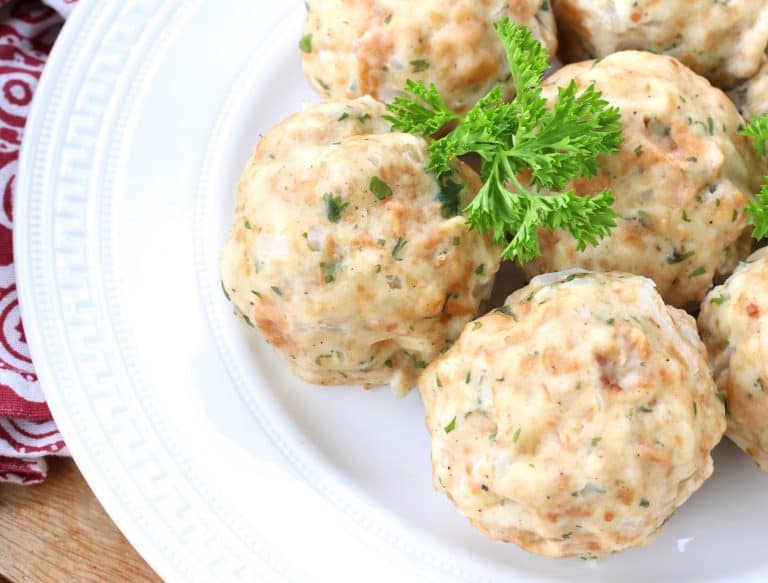
These Semmelknödel (German bread dumplings) have always been a favorite mine. It doesn’t matter what they’re served with – drenched in gravy these Knödel are pure heaven!
What Are Semmelknödel?
Semmelknödel (also called Klöße) or German bread dumplings are a specialty of the Bavarian region of Germany. My mother is from Bavaria, a favorite family vacation destination from where I grew up a little further north in Swabia. My mom also spent several years of her childhood in Thüringen (Thuringia) where the other famous German dumplings come from: Kartoffelklöße, aka German Potato Dumplings. Both kinds of dumplings are exquisite and I grew up with my mom and Oma cooking both kinds. Today we’re featuring the former, Bavarian Semmelknödel.

Ingredients
This Semmel Knödel recipe is pretty standard: Diced hardened bread rolls, onions, butter, fresh parsley, milk, eggs, salt, pepper and often a dash of freshly ground nutmeg.
Another variation, Speckknödel (bacon dumplings), are prepared exactly the same way only they have the addition of cooked bacon. That option is included in our recipe.
German bread dumplings are easy to make and they also freeze well, so I like to double or triple the batch, cook them, freeze them separated on cookie sheets, and then transfer them to ziplock freezer bags. Then when I need them all I have to do is thaw and reheat them covered in the microwave. Your Semmelknödel are as good as new!
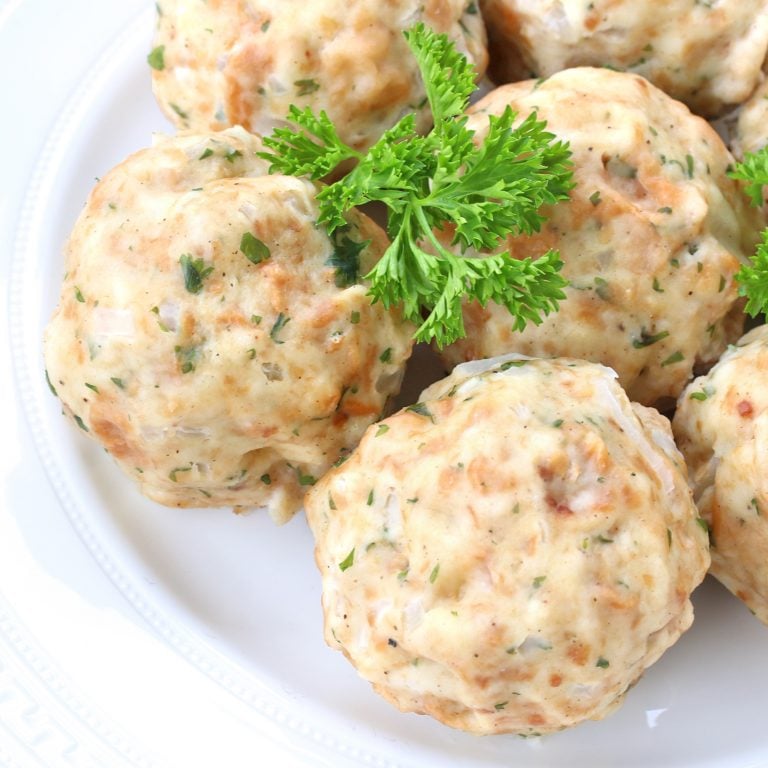
German Bread Dumplings Recipe
Let’s get started!
Let the rolls/bread sit out for a few days until hard. Chop the hardened bread into small cubes and place them in a large bowl.
Note: It’s much more convenient to use bags of unseasoned bread stuffing – it’s already cubed, simply let it dry out a little longer. (I do not advise using croutons though as they’re too hard.)
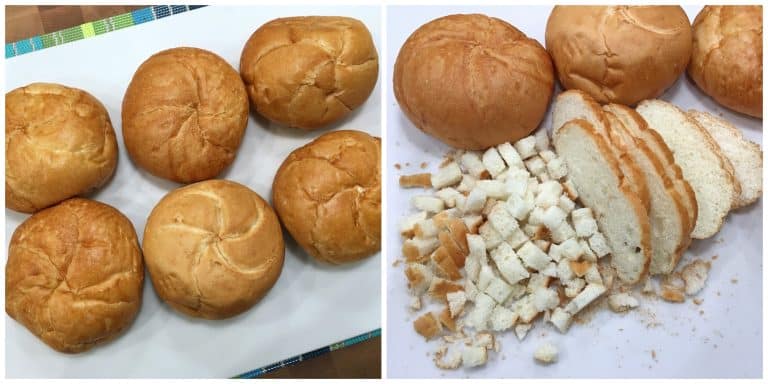
Pour the hot milk over the bread, cover, and let sit for 20-30 minutes or until softened.
Heat the butter in a frying pan and cook the onions just until transparent, do not brown them.
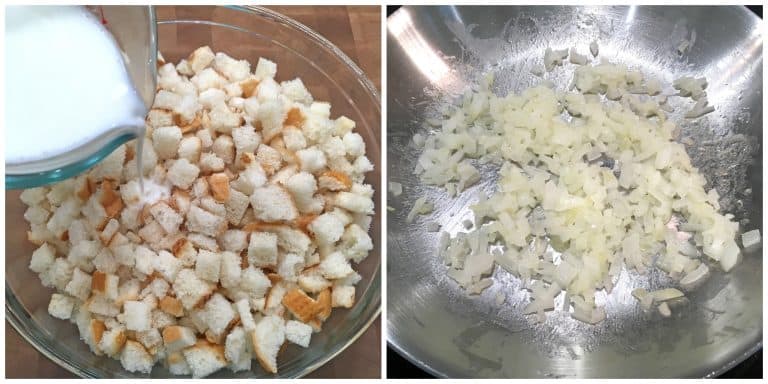
Add the cooked onions to the bread mixture along with the eggs, cooked bacon (if using), parsley, salt, pepper and nutmeg. Knead the mixture together with your hands until very thoroughly combined, breaking up as many of the bread cubes as you can until it’s a soft and chunky-smooth consistency. If the dough is too wet, add breadcrumbs (not flour).
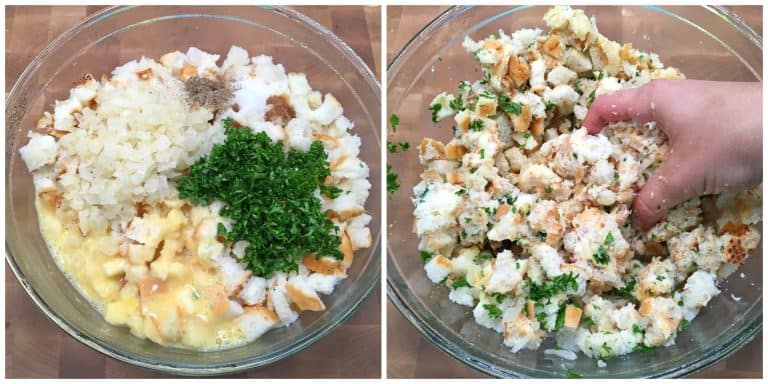
Wet your hands to prevent the dough from sticking and form Knödel about the size of a tennis ball (they will expand slightly when cooked). Press the Knoedel between your palms to make sure they’re nice and compact.
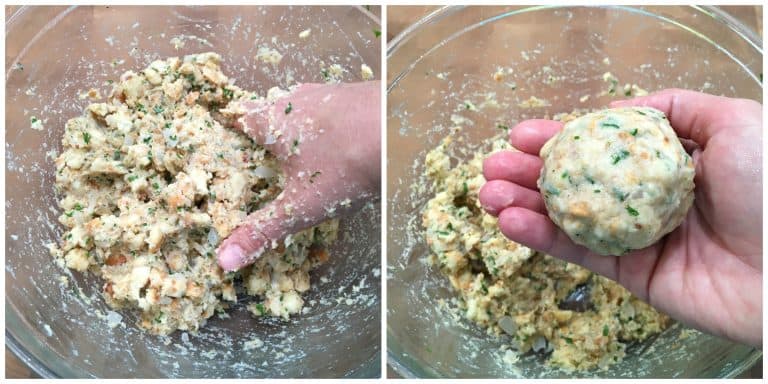
Bring a large, wide pot of lightly salted water to a very light simmer – not boiling but just on the verge of boiling with lots of tiny bubbles floating up.
Carefully drop the Semmel Knoedel in the water and let them lightly simmer for 15-20 minutes. Do not at any point let the water boil or you risk your Knödel losing shape or falling apart. Carefully lift them out with a slotted spoon.
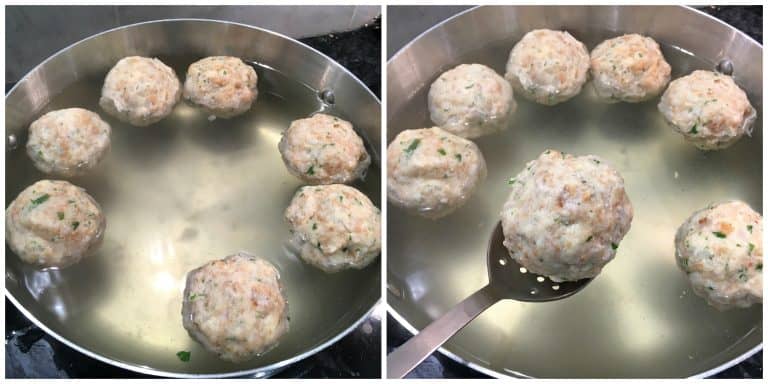
How to Freeze German Bread Dumplings
Let them cool completely, place them spread apart on a cookie sheet and freeze them, then transfer them to a freezer bag or container. To reheat, let them thaw and reheat them covered (to create some steam) in the microwave.
Makes 6-7 Semmelknödel, depending on the size.
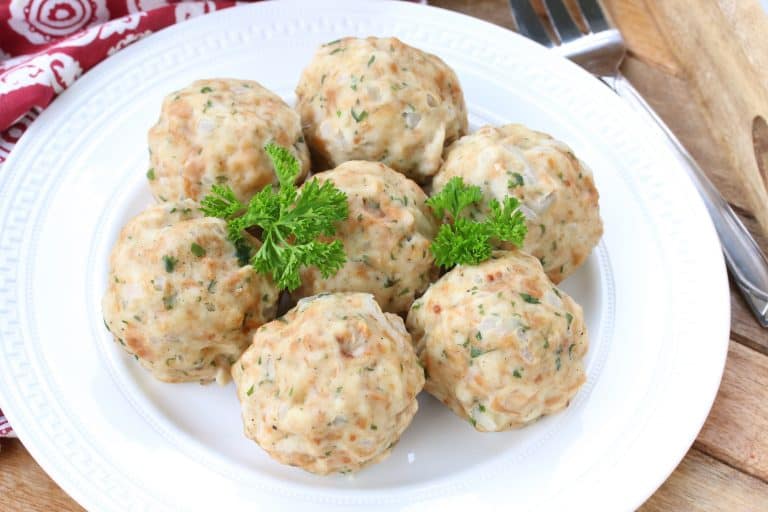
What to Serve With German Bread Dumplings
Semmelknödel, or German bread dumplings, are served as a side dish to accompany a variety of main dishes, especially sauce-based dishes, both meat and vegetarian sauces. Here are some common dishes you can pair with your homemade Semmelknoedel:
- Sauerbraten
- Jägerschnitzel
- Rouladen
- Geschnetzeltes or Zurich Ragout
- German Goulash, Hungarian Goulash, Szegedin Goulash or Pörkölt.
- Gravies and Sauces such as Mushroom Gravy, Onion Gravy, Rahm Sauce, Turkey Gravy, and Hungarian Mushroom Sauce.
- Roast Meats like a beef roast, Pot Roast, Tri Tip Roast, or pork roast such as Senfbraten (German pork roasted with mustard gravy). Also roast game, roast poultry, and Schweinshaxe.
- Bratwurst or other sausages
- German Red Cabbage (Rotkohl): This traditionally accompanies beef dishes.
- Sauerkraut: This traditionally accompanies pork dishes.
Enjoy!
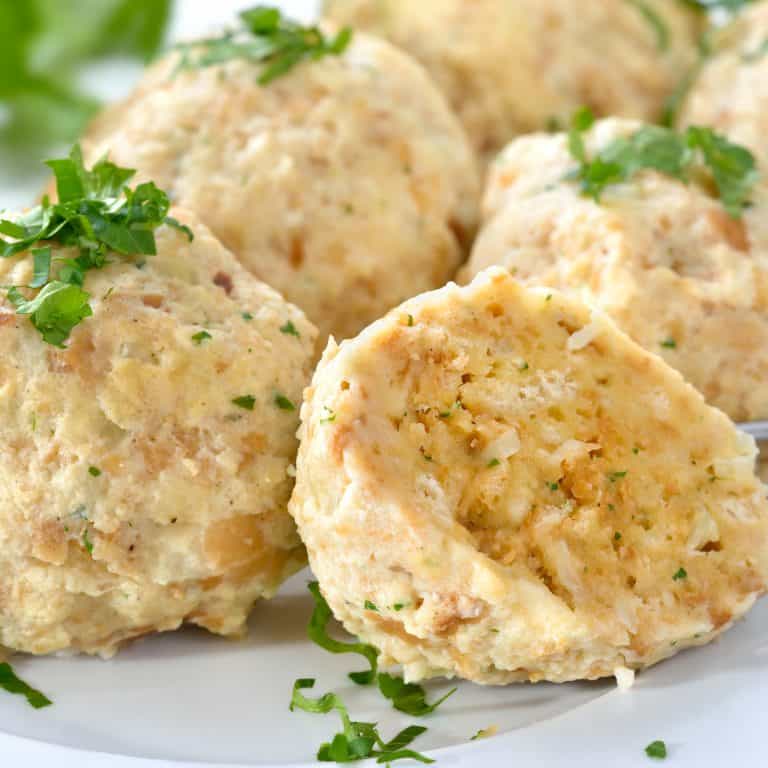
Save This Recipe
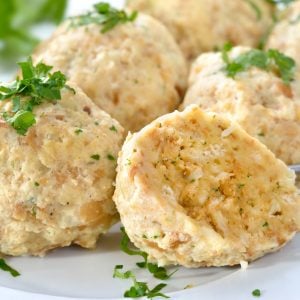
Semmelknödel (German Bread Dumplings)
Ingredients
- 11 ounces of white crusty bread (traditionally Brötchen/crispy bread rolls are used) , left to sit out for a few days to get hard and then diced into small cubes
- Note: It’s more convenient to use bags of unseasoned bread stuffing – it’s already cubed, simply let it dry out a little longer. (I do not advise using croutons though as they’re too hard.)
- 1 cup hot milk
- 1 tablespoon butter
- 3/4 cup very finely diced yellow onion
- 4 strips bacon, diced and fried until crisp , optional for a variation called Speckknödel (Bacon Bread Dumplings)
- 2 large eggs , lightly beaten with a fork
- 3 tablespoons finely chopped fresh parsley
- 1 teaspoon salt (you can use less if using bacon)
- 1/4 teaspoon freshly ground black pepper
- 1/8 teaspoon freshly ground nutmeg
- breadcrumbs, as needed
Instructions
- Chop the hardened bread into small cubes and place them in a large bowl. Pour the hot milk over the bread, cover and let sit for 20-30 minutes or until softened.
- Heat the butter in a frying pan and cook the onions just until transparent, do not brown them. Add the cooked onions to the bread mixture along with the eggs, cooked bacon (if using), parsley, salt, pepper and nutmeg. Knead the mixture together with your hands until very thoroughly combined, breaking up as many of the bread cubes as you can until it’s a soft and chunky-smooth consistency. If the dough is too wet, add breadcrumbs (not flour).
- Wet your hands to prevent the dough from sticking and form Knödel about the size of a tennis ball (they will expand slightly when cooked). Press the Knoedel between your palms to make sure they're nice and compact. Bring a large, wide pot of lightly salted water to a very light simmer – not boiling but just on the verge of boiling with tiny fizzy bubbles floating up. Carefully drop the Semmel Knoedel in the water and let them "steep" 15-20 minutes. Do not at any point let the water boil or you risk your Knödel losing shape or falling apart. Carefully lift them out with a slotted spoon. Serve with Rouladen, Sauerbraten, Senfbraten, Geschnetzeltes, Jaegerschnitzel, etc.
- To Freeze The Knödel: Let them cool completely, place them spread apart on a cookie sheet and freeze them, then transfer them to a freezer bag or container. To reheat, let them thaw and reheat them covered (to create some steam) in the microwave.
- Makes 6-7 Semmelknödel, depending on the size.
Nutrition
Originally published on The Daring Gourmet October 9, 2018



















These just fell completely apart on me. I had the water just right, put them in like I was putting a baby to bed and within about a minute they simply all disintegrated.
Suggestions?
Hi Chris, the most likely problem was the bread itself – that it wasn’t stale/hard enough. The second thing I’d look at is whether you made any other alterations to the ingredients or quantities…
Pretty forgiving recipe. Discovered after the fact that I had made some miscalculations, but all turned out delicious!
I’m glad it was a success, Andy, thank you!
My Mom taught me to make knoedels which she had learned from her mother in law, who was from Auchberg ding a ding in Bavaria. She made raw potatoes knoedels. They were very similar but added grated raw potatoes to the mixture, and served with sauerbraten.
I simply adore these dumplings especially with rouladen or a proper sauerbratten. My mother and I would take the leftover dumplings slice them into about quarter to half inch thick rounds then fry them up in slightly browned butter for a snack or a side dish later absolutely yummy.
Thank you, Jesse! And YES, that’s exactly what my Mutti does with the leftovers, so yummy!
I made these for my daughter and her (picky eater) husband and they BOTH loved them. I think my bread may not have been stale enough though because they didn’t turn out (in texture) the way my Mutti’s always turned out. They were very mushy when I took them out of the water. I drained them on paper towels and then put them in my air fryer for a few minutes to dry up and firm up the outsides a bit and they were better but I’d like to know what I did wrong. Perhaps you could add a bit of trouble-shooting advice to this recipe for best results. Possible areas I went wrong for example might have been not using stale enough bread, not letting the bread sit long enough after pouring the milk over, using the wrong type of bread (loaf instead of buns), size of cubes too big, wrong consistency (not enough bread crumbs), etc.
Hi Susanne, I’m so glad they were a family hit, thank you! <3 Yes, the issue is that they weren't stale/hard enough. The bread needs to sit out until it is hard. Hard like dried croutons hard.
Hi, our family used to make these as a child and i always loved them. I am in a GF house now but going right ahead with a gf white bread.
Anyway my question is can i premake the balls uncooked and leave them on a tray or waxed paper and lightly covered for an hour or two before cooking them?
Thanks for your thoughts!
Hi Andy, yes you can. I’d keep them in the fridge until you’re ready to cook them.
Hi Kimberly, our mom was from Salzburg Austria and made these alot. I’m glad I found this recipe. My brother loves these. I like the Knodel when it’s cold. I make a salad out of it. Diced knodel, chopped onion,salt, pepper,cider vinegar and oil. I don’t care for white vinegar and I love cider vinegar. The Knodel has to be firm. It is so good. If I want to make liver knodel, how much beef liver do I use. I never saw how much liver our mom used.
I was not able to
Hi Glenda, thank you so much for the feedback and I absolutely LOVE your idea for incorporating these cold into salads! I actually made a note a little while ago to remind me to work on a Leberknödel recipe and hope to get to that sooner than later :)
Our mother was from Salzburg, Austria and would make these. I’m glad I found this recipe. I made some last week and doing another batch now 1-9-25. I myself let the knodel get cold and then I dice it up, put it in a bowl, add salt, pepper, cider vinegar, and onions. I eat it like a salad. I really love it this way.